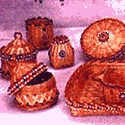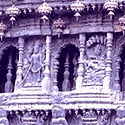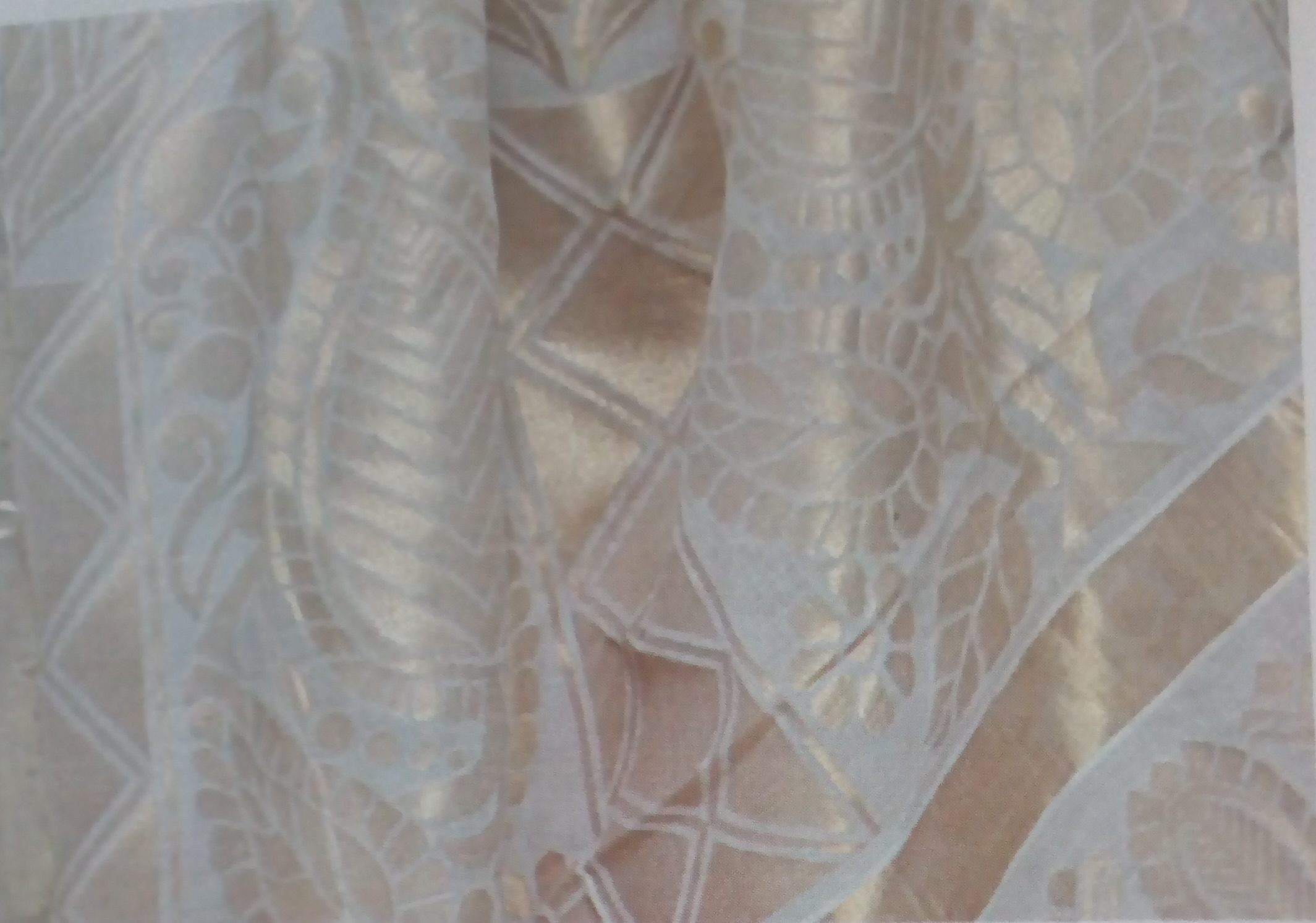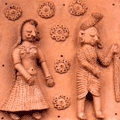Vaas Kaam/Cane and Bamboo of Gujarat,
In a majority of the villages in Gujarat traditional bamboo work provides articles required by the agrarian community. The western part of Gujarat is engaged in the making of cane and bamboo products. Ambapada is famous for decorative articles made from bamboo roots.
In a majority of the villages in Gujarat traditional bamboo work provides articles required by the agrarian community. The western part of Gujarat is engaged in the making of cane and bamboo products. Ambapada is famous for decorative articles made from bamboo roots.
Vahanam/Temple Chariots of Tamil Nadu,
The finest wooden carving are in the temples of Tamil Nadu and the piece-de-resistance are the processional chariots for the deities; these include numerous mounts/ vahanas and small pillared shrines/ rathams for the deities. The temple woodcarvers and carpenters belong to the Kammaalar caste. Patronage of the traditional crafts demanding fine detailing has petered down, so the number of craftsmen practicing the art have decreased. Temple chariots vary in size and can have 1-8 meters of intricate carving, consisting of multiple set-in panels of deities, mythical animals like yaalis and makaras, real animals, ganas, dancers, and decorative floral motifs. The carvings are detailed and stylised in high-relief and are very sensitively carved. The temple car is like a huge vimana resting on 4-8 massive wheels; it serves as a shrine and platform for the temple deity. The effects are very grand as elaborately decorated colourful cloth panels are tied to the wooden structure. The temple car carries the uthsavam or festival deity on the highest platform, crowned with jewels and garlanded with flowers. With the deity on the wooden base are a large painted wooden charioteer, two painted wooden guardians and two prancing white horses. The fully decorated temple car is pulled with thick ropes by devotees through the streets of the village or town during a special festival, once a year. Ten days preceding the Tamil New Year (14 April), the deity is taken out daily in a procession on the mounts : singam (lion), kaamadhenu (winged cow), annapakshi (mythical bird), vimaana (flying chariot), vrishabham (bull), horse, smaller temple car, ratha and the pushpalaka (a type of open shrine). Temples also have wooden elephant and cobra mounts which are painted and embossed with brass-plating, silver-plating or silver-with -gold, for the procession of the deity at festivals. The plating is done by the carpenter himself.
The finest wooden carving are in the temples of Tamil Nadu and the piece-de-resistance are the processional chariots for the deities; these include numerous mounts/ vahanas and small pillared shrines/ rathams for the deities. The temple woodcarvers and carpenters belong to the Kammaalar caste. Patronage of the traditional crafts demanding fine detailing has petered down, so the number of craftsmen practicing the art have decreased. Temple chariots vary in size and can have 1-8 meters of intricate carving, consisting of multiple set-in panels of deities, mythical animals like yaalis and makaras, real animals, ganas, dancers, and decorative floral motifs. The carvings are detailed and stylised in high-relief and are very sensitively carved. The temple car is like a huge vimana resting on 4-8 massive wheels; it serves as a shrine and platform for the temple deity. The effects are very grand as elaborately decorated colourful cloth panels are tied to the wooden structure. The temple car carries the uthsavam or festival deity on the highest platform, crowned with jewels and garlanded with flowers. With the deity on the wooden base are a large painted wooden charioteer, two painted wooden guardians and two prancing white horses. The fully decorated temple car is pulled with thick ropes by devotees through the streets of the village or town during a special festival, once a year. Ten days preceding the Tamil New Year (14 April), the deity is taken out daily in a procession on the mounts : singam (lion), kaamadhenu (winged cow), annapakshi (mythical bird), vimaana (flying chariot), vrishabham (bull), horse, smaller temple car, ratha and the pushpalaka (a type of open shrine). Temples also have wooden elephant and cobra mounts which are painted and embossed with brass-plating, silver-plating or silver-with -gold, for the procession of the deity at festivals. The plating is done by the carpenter himself.
Vallam, Kettuvallam Boat Making of Kerala,
In the backwaters of Alappuzha, Kottayam and Pathanamihitta the vallam and the kettuvallam wooden boats continue to be used for transportation. Boat builders can be found in Alappuzha and Tattampally While the chudanvallam or snake boats measuring 130-150 feet in length are used for sporting events and the regatta at Kumarakom, these boats are usually manned by 100 or more rowers who practice for months to achieve the smooth coordination required for them to perform effectively as a team during the prestigious Nehru cup tournament. The taravallam is a small boat used to ferry a maximum of three to four people. It is usually has a U-shaped base to enhance the vessel's stability. The boat gets its name from the process employed in its construction - that of hammering tara or nails into the planks. The kettuvallam is the huge open to air boat propelled by means of long bamboo punts that are built to carry 7 to 9 lorry loads of cargo and is constructed by tying planks together. Its roofing, when required, is made of mats of woven bamboo splits that are tied onto vaulted bamboo splits that are tied onto vaulted bamboo frames. The kettuvallam is now used largely as a house-boat for tourists for which pupose it has been redesigned. Its roof height has been raised for increased head-room, windows and other openings provided for light, better ventilation and an uninhibited view of the passing scenery. The interior space is usually separated with bamboo screen to form bedrooms with a common toilet, a living space, a kitchen and a deck balcony. The construction of the vallam begins with the formation of the spine - the eravupalaka, central plank, that runs through the entire length of the boat. Once the secondary planks are coated with neem oil, they are heated on a fire fed with coconut husk, and bent to the curvature required to join them to the body with a simple lip and groove joint and then secured with nylon ropes. Teams of two start to work on the kettu or tying, one man inside the vallam and the other standing outside - they first pass the rope over a bundle of coconut husk embedded in the grooved joint and through one of the holes drilled along the length of each plank while the second draws out the rope and tightens it as the man inside hammers the rope bundle into a condensed mass simultaneously. The rope is then inserted into the diagonally situated hole and pulled out by the man seated inside; the process is repeated until a crisscross pattern is achieved. The kombu and thalamaram, or two mastheads, are made separately and attached to the main body. A paste of charcoal powder, chanchalyam (arpus), lime powder and fish oil is applied on the kettu to prevent water from seeping in; it also serves to waterproof the wood and protect it from termite infestation. The outside of the vallam is coated with a mixture of cashew oil and coal powder to give it its characteristic black color.
In the backwaters of Alappuzha, Kottayam and Pathanamihitta the vallam and the kettuvallam wooden boats continue to be used for transportation. Boat builders can be found in Alappuzha and Tattampally While the chudanvallam or snake boats measuring 130-150 feet in length are used for sporting events and the regatta at Kumarakom, these boats are usually manned by 100 or more rowers who practice for months to achieve the smooth coordination required for them to perform effectively as a team during the prestigious Nehru cup tournament. The taravallam is a small boat used to ferry a maximum of three to four people. It is usually has a U-shaped base to enhance the vessel's stability. The boat gets its name from the process employed in its construction - that of hammering tara or nails into the planks. The kettuvallam is the huge open to air boat propelled by means of long bamboo punts that are built to carry 7 to 9 lorry loads of cargo and is constructed by tying planks together. Its roofing, when required, is made of mats of woven bamboo splits that are tied onto vaulted bamboo splits that are tied onto vaulted bamboo frames. The kettuvallam is now used largely as a house-boat for tourists for which pupose it has been redesigned. Its roof height has been raised for increased head-room, windows and other openings provided for light, better ventilation and an uninhibited view of the passing scenery. The interior space is usually separated with bamboo screen to form bedrooms with a common toilet, a living space, a kitchen and a deck balcony. The construction of the vallam begins with the formation of the spine - the eravupalaka, central plank, that runs through the entire length of the boat. Once the secondary planks are coated with neem oil, they are heated on a fire fed with coconut husk, and bent to the curvature required to join them to the body with a simple lip and groove joint and then secured with nylon ropes. Teams of two start to work on the kettu or tying, one man inside the vallam and the other standing outside - they first pass the rope over a bundle of coconut husk embedded in the grooved joint and through one of the holes drilled along the length of each plank while the second draws out the rope and tightens it as the man inside hammers the rope bundle into a condensed mass simultaneously. The rope is then inserted into the diagonally situated hole and pulled out by the man seated inside; the process is repeated until a crisscross pattern is achieved. The kombu and thalamaram, or two mastheads, are made separately and attached to the main body. A paste of charcoal powder, chanchalyam (arpus), lime powder and fish oil is applied on the kettu to prevent water from seeping in; it also serves to waterproof the wood and protect it from termite infestation. The outside of the vallam is coated with a mixture of cashew oil and coal powder to give it its characteristic black color.
Varanasi Soft Stone Jali Work of Uttar Pradesh,
Jali or fretwork is intricately carved on soft stone and its process requires supreme mastery of masonry and design making. The Varanasi soft stone jali work epitomizes both high skill and a superior quality of craftsmanship. Delicately chiseled and decorated with inlay work these elaborately carved jalis demand time in their making along with the skill and creativity of the masters. In Varanasi the jali craft work can be seen on forts, zamindari homes, places of worship and ancient monuments all of which are a testimony to its antiquity. Statues of religious significance are also made using this technique. To further enhance the beauty of these sculptures they would be embedded with semi-precious stones and shell-work. Today small items of utility and decor are also produced such as table tops, boxes, coasters, trays, etc. Given their small size and the intricate work of jali making the Varanasi soft stone craft remains a skill of the masters.
Jali or fretwork is intricately carved on soft stone and its process requires supreme mastery of masonry and design making. The Varanasi soft stone jali work epitomizes both high skill and a superior quality of craftsmanship. Delicately chiseled and decorated with inlay work these elaborately carved jalis demand time in their making along with the skill and creativity of the masters. In Varanasi the jali craft work can be seen on forts, zamindari homes, places of worship and ancient monuments all of which are a testimony to its antiquity. Statues of religious significance are also made using this technique. To further enhance the beauty of these sculptures they would be embedded with semi-precious stones and shell-work. Today small items of utility and decor are also produced such as table tops, boxes, coasters, trays, etc. Given their small size and the intricate work of jali making the Varanasi soft stone craft remains a skill of the masters.
Veena String Instrument of Vizianagram, Andhra Pradesh,
The three present day production clusters in the Vizianagara district are Bobbili, Gollapalli and Wadada/Vodada. Bobbili cluster has reached its zenith with resonating sound worthy of Veena maestros. The veena is made of a single piece of wood from the jackfruit tree. Plastic is used instead of ivory and stag horn is made through inlay. Two types of products are made Saraswati Veena and Miniature Veena. Tools used are Axe, Saw, Chisels, Pliers, Hand drill, Calipers, Compass, Files, Planner and Hand lathe.
The three present day production clusters in the Vizianagara district are Bobbili, Gollapalli and Wadada/Vodada. Bobbili cluster has reached its zenith with resonating sound worthy of Veena maestros. The veena is made of a single piece of wood from the jackfruit tree. Plastic is used instead of ivory and stag horn is made through inlay. Two types of products are made Saraswati Veena and Miniature Veena. Tools used are Axe, Saw, Chisels, Pliers, Hand drill, Calipers, Compass, Files, Planner and Hand lathe.
Votive Terracottas of Molela, Rajasthan,
Murtikala, the art of making terracotta votive murtis or religious idols is practised in Molela, a small town 40 km north of Udaipur, in Rajasthan. While, originally, the murtis were standing representations of local deities, the Mother Goddess, Nagdeva and various other forms, today they are often mounted on tiles or plaques to be hung on the walls of temples and homes. They can either have a natural terracotta hue, or can be multi-coloured, depending on the demand of the customer, and both varieties can be seen in various shrines and temples in Rajasthan and Gujarat. While the potters of Molela are known for - and draw their livelihood from - votive murtis and depiction(s) of heroes and heroines from traditional local legends, they also depict scenes that express what the artisan sees around him. Khemraj Kumhar, a master craftsman, once created a 6 feet by 4 feet panel, consisting of 24 tiles, depicting all the stages in a woman's life.
Murtikala, the art of making terracotta votive murtis or religious idols is practised in Molela, a small town 40 km north of Udaipur, in Rajasthan. While, originally, the murtis were standing representations of local deities, the Mother Goddess, Nagdeva and various other forms, today they are often mounted on tiles or plaques to be hung on the walls of temples and homes. They can either have a natural terracotta hue, or can be multi-coloured, depending on the demand of the customer, and both varieties can be seen in various shrines and temples in Rajasthan and Gujarat. While the potters of Molela are known for - and draw their livelihood from - votive murtis and depiction(s) of heroes and heroines from traditional local legends, they also depict scenes that express what the artisan sees around him. Khemraj Kumhar, a master craftsman, once created a 6 feet by 4 feet panel, consisting of 24 tiles, depicting all the stages in a woman's life.





